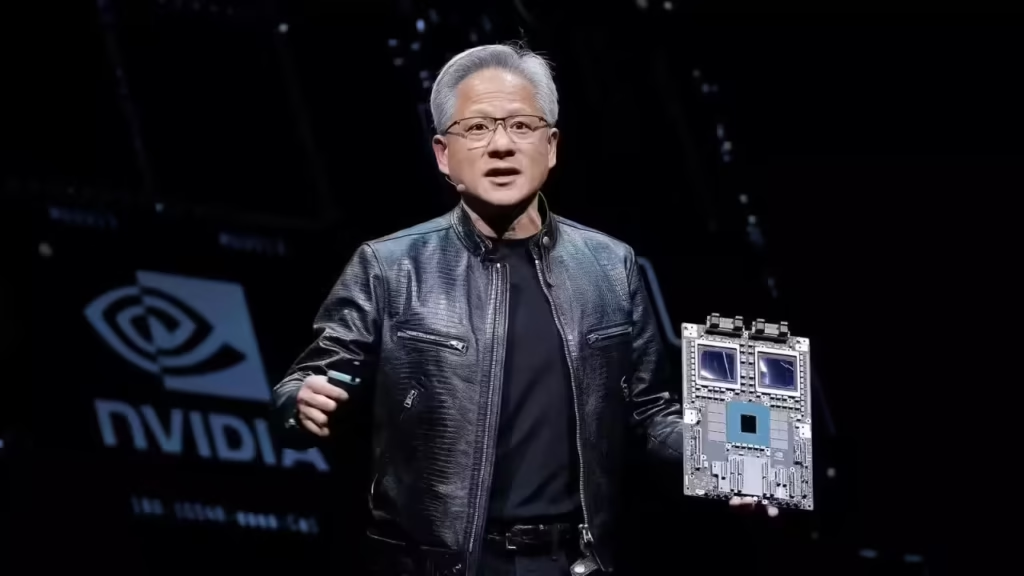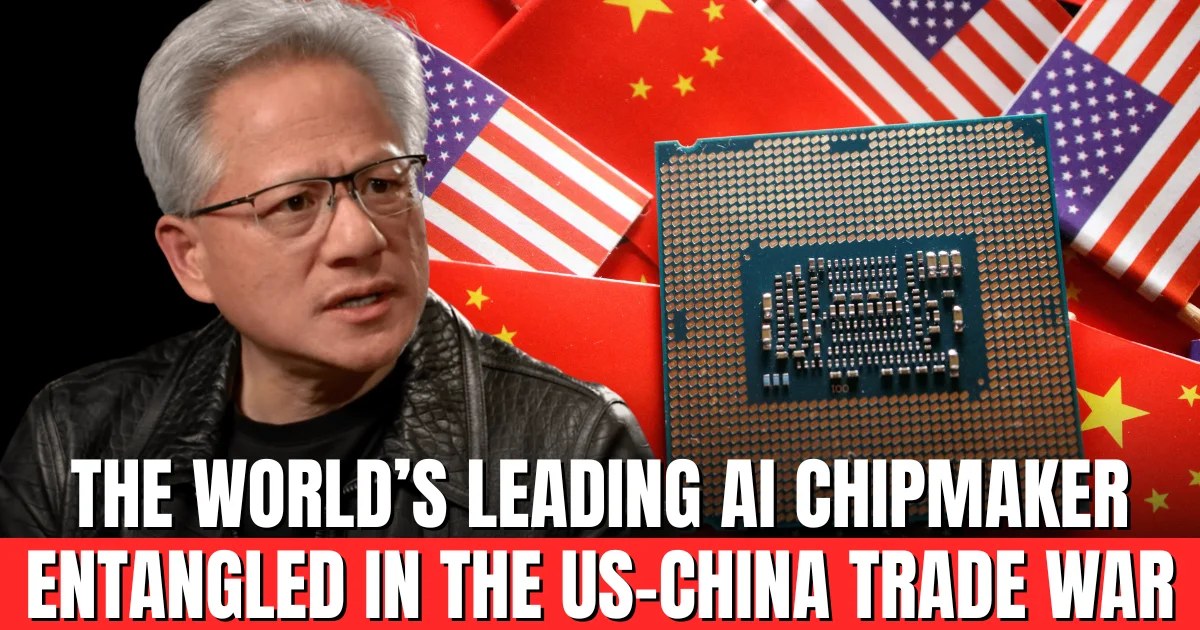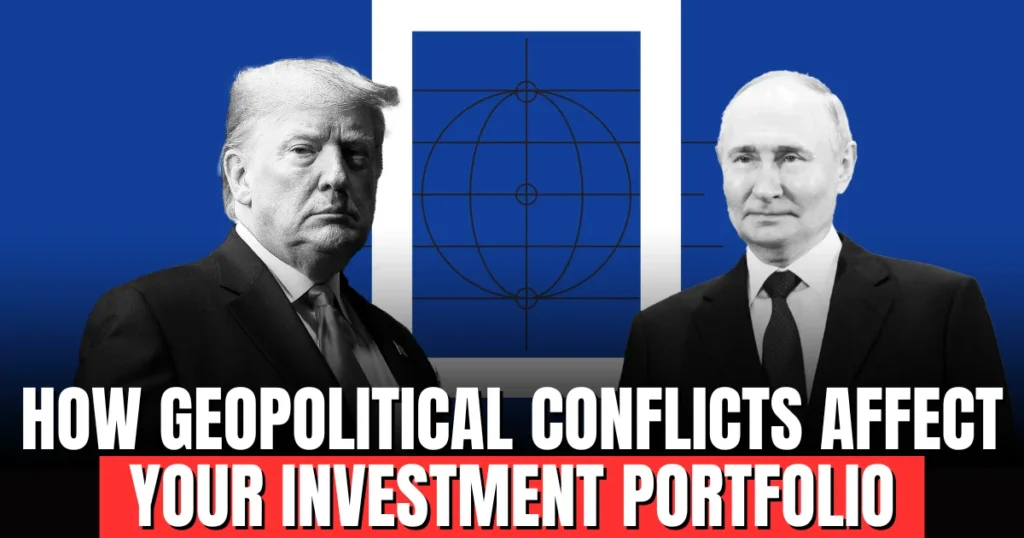Nvidia, the world’s top AI chipmaker, has become a focal point in the US-China trade war. Discover how export controls, tariffs, and national security concerns have placed Nvidia in the geopolitical spotlight
Table of Contents
Why Is Nvidia, the World’s Leading AI Chipmaker, Entangled in the US-China Trade War?
Introduction
Nvidia’s dominance in artificial intelligence (AI) chipmaking has made it a global powerhouse — and a political target. As the United States and China escalate their tech rivalry, Nvidia’s cutting-edge chips have become more than just components; they’re now instruments of geopolitical power.
With a market capitalization nearing $5 trillion, Nvidia’s technology powers massive data centers behind leading AI firms such as OpenAI — but that same success has placed the California-based company in the middle of an intensifying trade war between Washington and Beijing.

Nvidia’s Rise to AI Supremacy
Founded in 1993 by Jensen Huang, Nvidia began as a graphics processing startup. Over three decades, Huang transformed it into the world’s most valuable semiconductor firm.
Today, Nvidia’s GPUs (graphics processing units) are the backbone of generative AI models and high-performance computing — fueling innovations in machine learning, robotics, and cloud infrastructure.
But this dominance has come at a cost: the company’s massive sales in China — once nearly 25% of its total GPU business — are now constrained by political and trade barriers.
How the US-China Trade War Pulled Nvidia In
The tension began with President Donald Trump’s sweeping tariffs and expanded to include export restrictions on advanced chips like Nvidia’s H20 model. The goal was clear — slow down China’s AI progress and keep the United States in the lead.
However, this decision infuriated Beijing, which retaliated with its own restrictions and import bans.
In a controversial turn, the White House temporarily reversed course, allowing Nvidia and AMD to sell chips to China — but with a catch. Companies would surrender 15% of China-generated revenue to the US in exchange for export licenses.
This uneasy truce did little to cool tensions. By August, both nations were trading fresh rounds of tariffs, with Trump announcing a 100% tariff on Chinese goods over rare earth mineral disputes.
Jensen Huang: The Man Behind Nvidia’s Global Vision
Nvidia’s co-founder and CEO, Jensen Huang, is one of the most influential figures in the modern tech landscape.
Born in Taiwan and educated in the United States, Huang has been hailed as a “rockstar” in the AI world — amassing a net worth exceeding $160 billion. His leadership style combines deep technical expertise with bold risk-taking.
Huang has warned repeatedly that restricting AI chip sales to China could backfire, driving Chinese firms to develop homegrown alternatives faster.
“Restricting sales will only encourage China to innovate independently,” Huang emphasized in past interviews.

Nvidia’s Role in the Global AI Chip Race
Nvidia’s technology forms the backbone of AI ecosystems worldwide. Its chips power OpenAI’s ChatGPT, Google’s Gemini, and countless data centers globally.
The company recently announced plans to invest up to $100 billion in OpenAI through 2026 — further cementing its influence.
Despite competitors like AMD gaining traction, Nvidia’s CUDA architecture and H100 processors remain unmatched in AI workloads and training efficiency.
“Nvidia essentially created the architecture for anyone who develops AI,” says NYU Professor Arun Sundararajan.
Is Nvidia Skirting Export Rules?
The U.S. Commerce Department is investigating whether Nvidia’s client, Singapore-based Megaspeed, may be helping Chinese entities bypass export controls.
Nvidia denies any wrongdoing, asserting compliance with U.S. export laws.
“We’ve not identified any reason to believe products have been diverted,” Nvidia said, emphasizing its cooperation with authorities.
Still, concerns persist that black-market resales or indirect transfers could give China access to Nvidia chips — accelerating Chinese AI development.
Experts warn that over-restriction could backfire, pushing China to innovate faster and build self-reliant chip ecosystems.
China’s Reaction and the Future of AI Trade
In response to Washington’s chip restrictions, Beijing has tightened import rules, effectively banning certain U.S. processors. This tug-of-war has disrupted supply chains and intensified the race for AI supremacy.
Both nations are pouring billions into semiconductor independence — a trend that could reshape global technology leadership in the coming decade.
As AI becomes a matter of national security, Nvidia’s role has shifted from commercial powerhouse to strategic bargaining chip between two superpowers.
FAQs
1. Why is Nvidia crucial in the US-China trade war?
Nvidia produces advanced AI chips vital for AI development. The U.S. restricted their export to China to curb Beijing’s AI ambitions, making Nvidia central to the trade conflict.
2. How much of Nvidia’s revenue comes from China?
Before restrictions, roughly 25% of Nvidia’s GPU sales came from China — a major share of its global business.
3. What are Nvidia’s H20 chips?
The H20 chips were specifically designed to comply with U.S. export rules while still being sold in China. They balance performance with regulatory limits.
4. Is Nvidia under investigation for trade violations?
Yes, the U.S. Commerce Department is probing whether Nvidia’s customer Megaspeed helped China sidestep export controls. Nvidia has denied any misconduct.
5. Could China develop its own AI chips?
Absolutely. Analysts believe that restricting Nvidia’s technology could accelerate China’s domestic chip innovation in the long run.
Conclusion
Nvidia’s story is a powerful reminder that technology and geopolitics are now inseparable. As AI becomes the cornerstone of global innovation, Nvidia stands at the intersection of profit, progress, and political power.
Whether as a tool of diplomacy or a symbol of innovation, Nvidia’s influence in the US-China trade war underscores a critical truth: the future of AI will be shaped not just by engineers, but by policymakers.

